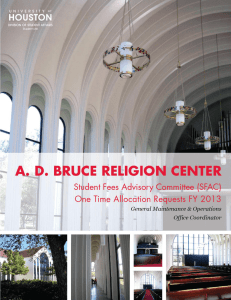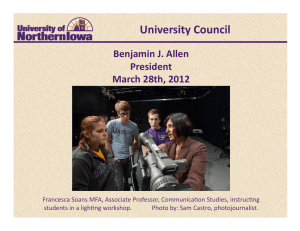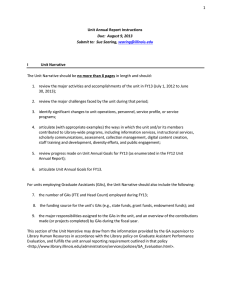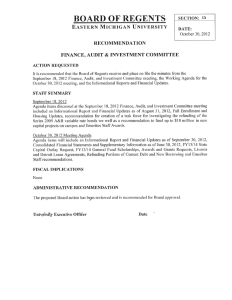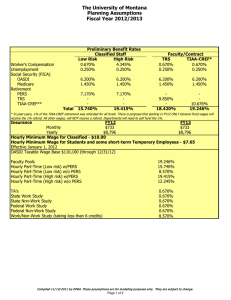Reference 6 - FY13�Capital Budget Guidelines
advertisement
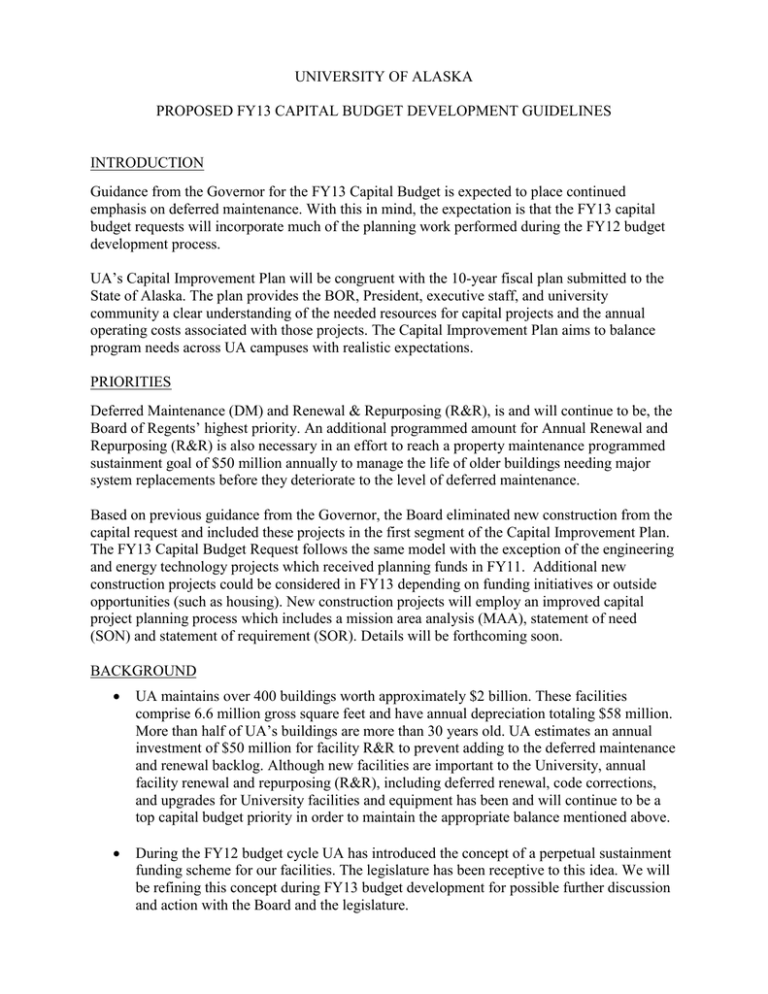
UNIVERSITY OF ALASKA PROPOSED FY13 CAPITAL BUDGET DEVELOPMENT GUIDELINES INTRODUCTION Guidance from the Governor for the FY13 Capital Budget is expected to place continued emphasis on deferred maintenance. With this in mind, the expectation is that the FY13 capital budget requests will incorporate much of the planning work performed during the FY12 budget development process. UA’s Capital Improvement Plan will be congruent with the 10-year fiscal plan submitted to the State of Alaska. The plan provides the BOR, President, executive staff, and university community a clear understanding of the needed resources for capital projects and the annual operating costs associated with those projects. The Capital Improvement Plan aims to balance program needs across UA campuses with realistic expectations. PRIORITIES Deferred Maintenance (DM) and Renewal & Repurposing (R&R), is and will continue to be, the Board of Regents’ highest priority. An additional programmed amount for Annual Renewal and Repurposing (R&R) is also necessary in an effort to reach a property maintenance programmed sustainment goal of $50 million annually to manage the life of older buildings needing major system replacements before they deteriorate to the level of deferred maintenance. Based on previous guidance from the Governor, the Board eliminated new construction from the capital request and included these projects in the first segment of the Capital Improvement Plan. The FY13 Capital Budget Request follows the same model with the exception of the engineering and energy technology projects which received planning funds in FY11. Additional new construction projects could be considered in FY13 depending on funding initiatives or outside opportunities (such as housing). New construction projects will employ an improved capital project planning process which includes a mission area analysis (MAA), statement of need (SON) and statement of requirement (SOR). Details will be forthcoming soon. BACKGROUND UA maintains over 400 buildings worth approximately $2 billion. These facilities comprise 6.6 million gross square feet and have annual depreciation totaling $58 million. More than half of UA’s buildings are more than 30 years old. UA estimates an annual investment of $50 million for facility R&R to prevent adding to the deferred maintenance and renewal backlog. Although new facilities are important to the University, annual facility renewal and repurposing (R&R), including deferred renewal, code corrections, and upgrades for University facilities and equipment has been and will continue to be a top capital budget priority in order to maintain the appropriate balance mentioned above. During the FY12 budget cycle UA has introduced the concept of a perpetual sustainment funding scheme for our facilities. The legislature has been receptive to this idea. We will be refining this concept during FY13 budget development for possible further discussion and action with the Board and the legislature. Over the past 10 years (FY02-FY11), UA has requested an average of $76.5 million in state funding for DM and R&R, but received an average of $18.4 million. The vast gap between funding required and funding received, in real dollars, has elevated UA’s deferred maintenance backlog from $200 million in 2000 to over $750 million as of September 2011. Extending the life of viable existing facilities is essential and the longer UA goes without adequate funding for facilities DM and R&R, the steeper the deferred maintenance curve climbs, and the of risk mission failure increases as well as the operating and maintenance unprogrammed expenses. Through its operating budget the University dedicates funding every year to routine and preventive maintenance and repair (M&R), and in FY10 dedicated over $32 million (approximately 1.5% of adjusted facility value) of its operating budget to this category some common industry standards prescribe 2-4 percent of current replacement value as the appropriate annual investment for M&R. Factors such as the age of the buildings, previous renovations, level of building use, and climate will determine the specific percentage. FY13 BUDGET TIMELINE Below are key dates in the FY13 budget development process. BOR indentifies dates for which the Board of Regents will be involved. June BOR - FY12 Operating and Capital Budget Acceptance BOR - FY12 Operating and Capital Budget Distribution Plans Approval July Initial meeting with the Governor’s Office of Management and Budget (OMB) and Legislative Finance Division to discuss FY13 program themes, fixed costs and capital budget needs August FY13 MAU Capital Budget Requests submitted to Statewide Budget Office including: capital budget requests and deferred maintenance lists List of expected leased properties and any projects needing potential debt financing FY13 budget meeting of the University of Alaska leadership to present and review MAU budget request priorities (to include a presentation by each Chancellor on the expected outcomes in FY12 and a general discussion of their 3-5 year planning horizon) September BOR - First Review of FY13 Operating, Capital Budget, and Capital Improvement Plan Formal budget meeting with Governor’s Office of Management and Budget (OMB) November BOR - FY13 Operating and Capital Budget Request Approval BOR - FY13 Capital Improvement Plan Approval Submit Board of Regents’ FY13 Budget to the Governor’s Office of Management and Budget (OMB)

